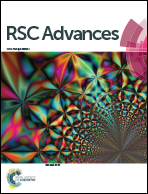Facile preparation of semimetallic WP2 as a novel photocatalyst with high photoactivity†
Abstract
Searching for inexpensive and earth-abundant photocatalysts with high activities has attracted considerable research in recent years. In this work, semimetallic tungsten diphosphide (WP2) micro-particles are explored as a novel photocatalyst for the first time. The WP2 particles were synthesized through a solid-state reaction route via vacuum encapsulation technique following by water washing. The first principle calculations and electric transport measurements show a semimetallic characteristic of WP2, however a strong absorption in the UV range is observed. The prepared WP2 particles exhibit an admirable photocatalytic activity towards oxidation of methyl orange and reduction of water for H2 evolution with the assistance of co-catalyst element Pt under UV light irradiation. Hydroxyl radicals detected by fluorescence spectroscopy in the solution in the presence of WP2 under UV light irradiation confirms the photoactivity. Furthermore, the photocatalyst shows a good photostability and reusability even after three successive experiment runs. Based on the experimental measurements and theoretical calculations, a possible photocatalytic mechanism is proposed for semimetallic WP2. The present study may provide a chance for practical applications of the semimetallic material WP2 in the field of photocatalysis.


 Please wait while we load your content...
Please wait while we load your content...